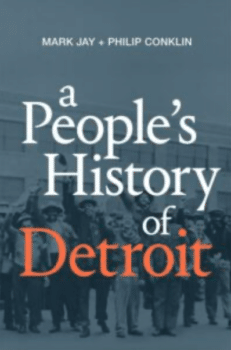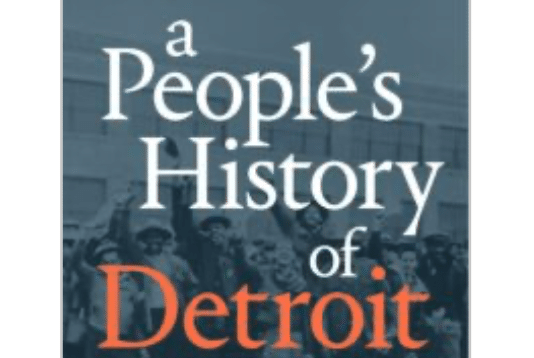
A People’s History of Detroit, Authors:Mark Jay and Philip Conklin
Bibliographic information: Duke University Press, Durham and London, 2020. 306 pp., $27.95 pb
ISBN:9781478008347
Composing a history of Detroit is an exercise in tying together many economic and social trends within a microcosm of class, race, and fraught politics. Mark Jay and Philip Conklin’s work discusses the 20th-century history of the city to offer a documentation of class struggle seen through the industrialization of the city in the early 20th century, the racial tensions of the post-World War II period, and, finally, the simultaneous processes of decay and development in the last three decades. To accomplish this, they reconstruct the aforementioned historical periods on Marxist terms, criticizing concepts of ‘development’, ‘renewal’, and ‘progress’ as common parts of the narratives presented by state and local government and business interests about the city. In creating today’s Detroit as a success story of contemporary capitalism, the authors argue that corporations and the state collaborated to dismantle not only worker-centric understandings of community and history, but also physically destroyed many predominately black and brown neighborhoods in the city. This destruction came paired with a creativity under capitalist logic that supposes Detroit’s current status quo as a fulfillment of some fundamentally American myth of renewal and rebirth. Creative destruction in this context, then, means paving over workers’ understandings of history (and their homes) and replacing them with capitalist myths and expensive apartment complexes. This is what they call ‘the interplay between creative destruction and mythologization’ (13).
The analysis provides a much-needed critique of the interplay between race and class in Detroit politics today. It moves from a direct political critique of the present (chapter 1) to offering historical analyses of workers and civil rights movements of the early and mid-20th century (central chapters 2-5). The authors make a cogent and timely case for a long history of anti-black mythmaking in capitalist politics in Detroit that is borne out in direct police violence and the economic violence of gentrification and incarceration under the guise of renewal and development.
A People’s History of Detroit offers a stark contrast to Nathan Bomey’s Detroit Resurrected, which covers a narrower historical period (roughly 2000 to 2013). It concludes that Detroit’s path towards a better future is to allow corporations to gentrify as much of the city as possible, as quickly as possible. In some respects, Jay and Conklin’s work serves as a broader, and more present-oriented articulation of Detroit’s racial and class history than is seen in Beth Thomkins Bates’ The Making of Black Detroit in the Age of Henry Ford. The work reviewed here, though not without some flaw, presents a systematic and critical history of Detroit that does not succumb to the myopia of Bomey’s work, and is willing to go further than Bates in terms of making a more direct analysis of the present conditions for the working class in Detroit today.
The book’s longest chapter, the first, details several of the major problems that face Detroit from a perspective sympathetic to the city’s working-class residents. The supposed ‘revitalization’ of the city is far from ideal in terms of providing economic and social opportunities for the city’s primarily black working class. In the wake of the Great Recession, a few hyper-wealthy interests (such as the owners of Little Cesar’s Pizza) are provided with sweetheart deals to ‘develop’ sections of the city. These developments are aimed clearly at the creation of corporate-owned housing that primarily benefits white, upper-middle-class suburbanites. Concurrently, an increasing proportion of the city’s black residents are being priced out of housing, much of which was given to corporate developers through the well-documented process of property-tax foreclosures within the city’s limits. All of this is done with the oversight of appointed managers who were given quasi-feudal power over the city’s financial, educational, and infrastructural processes over the preceding two decades.
The second chapter situates this racially fraught political geography within the broader contestations of anti-worker politics began by Ford and other automakers in the early part of the 20th century, setting the stage for increasing federal involvement in the city’s economic and political life. This involvement, Chapter Three develops, intensified during and after the Second World War. While there were some gains made due to wartime labour shortages in terms of pay, the vehement anti-communist rhetoric came with brutal use of violent policing tactics disproportionately deployed against the city’s growing left politics. This period saw the activities of Malcolm X, and, eventually, the growth of the Black Panthers as a reaction to decades of cooperation between anti-black unions and anticommunist government, local and national. Chapters Four and Five map those political struggles within the context of growing pressure from predominately white suburban interests for a pacification of black, especially left-leaning, calls for class and racial justice in the city in which they had built over the course of the preceding century. The results of decades of purposeful neglect and increasingly violent policing, the final chapter 5 and the conclusion detail, are as unsurprising as they are violent to the broader Detroit working class: underfunded (often closed) public schooling, few jobs, and repression of progressive political organizing, met with militarized police presence as a fact of everyday life have left much of the poor and working class in the city unable to afford housing. And with few opportunities for education or meaningful, well-paid work, the state seems all-too ready to hand large swaths of the city to corporations.
The book’s merits are many. Chief among them: the current work situations in Detroit’s so-called revitalization reflect a century of state and corporate cooperation against the interests of the working class. This is based on exploiting existing racial tensions to the ends of artificially lowering wages and generally subverting pro-worker organization by any means necessary up to and including deploying the military against American civilians in the streets. This discussion not only critically interrogates notions of post-Great Recession development within a class-conscious framework, but it also serves as a cautionary look into the future of American cities if we, as a society, continue to tolerate wholesale corporate governance of major economic centers.
Secondly, the work maintains a steadfast commitment to the intersectionality of contemporary Marxist analyses of urban political geography. Since the massive demographic shifts of the post-Civil War period, the powers that be in Detroit have systematically worked against the interests of black residents. Those powers include organizations such as unions and the Johnson administration that might, in less critical contexts, be understood as friends to the working class. To avoid this misconception, the author’s detailed history of the foundations of the Black Panthers as a reaction to decades of black folks’ exclusion from union decision-making and the government’s willingness to enforce ‘anticommunist’ violence against minorities provides excellent proof of the cooperation between the state, unions, and corporations to the ends of consolidation of the means of production, and now, real estate, in the hands of the few.
Beginning in the introduction and carrying through the work as a whole, the authors dedicate much of their analysis to the construction of pro-capitalist mythologies in Detroit. These mythologies make ready use of existing racial tensions to cast poor and working-class black folks as the enemy of first, development, and, now, renewal of the city. Taken together, these three major high points accomplish the book’s stated purpose, of rendering coherent the mechanisms by which a deeply capitalist, racist politics has taken deep root into Detroit’s political past and present.
Given that this work is presented as a history, one organizational choice is somewhat puzzling. The first chapter, which constitutes a full third of the length of the project, details the many problems and state-level abuses of economic and political governance that have occurred in the 21st century. As a Michigander, I take no issue with the presentation of these facts; the quasi-feudal system of unaccountable, often appointed, local ‘managers’ that our state has seen in recent decades has undoubtedly worsened economic life for the working class. By the 2020s, much of the pro-capitalist plan for gentrification has made working-class participation in, for example, home ownership and higher education a living nightmare for millions. The first chapter paints the current picture of economic challenges facing the working class in Detroit accurately, but does not place those challenges within a broader theoretical framework from the outset. This lack of a theoretical explanation in chapter one makes it more difficult for the reader to understand the economic and political processes that led to Detroit’s current state. The remainder of the work, proceeding temporally through the 20thcentury, does an excellent job of placing those contemporary problems within a broader Marxist framework. However, some readers might struggle with the various threads presented in Chapter One until the clear historical patterns are demonstrated in the following chapters. Since the first chapter lists contemporary problems without a clear connection to the critical Marxist analysis presented in later chapters, readers are left to hold a collection of current facts about Detroit in their memories without the benefit of a framework upon which to rest those facts. A second edition might do well to somewhat rearrange the chapters into temporal order: currently, the introductory chapter focuses mostly on the present, and chapters 2-5 walk more systematically through the period between 1913-2013.Doing so would make the work substantially more accessible to broader audiences which, given the importance and timeliness of the patterns and trends the work documents so well, might increase the overall impact of the work as a whole.
A People’s History of Detroit is a vitally important intervention into contemporary critical scholarship in several regards. First, it asks the reader to critically examine unions in their real, historical context. In the United States, this often means more than some willingness for union leadership to exploit racial tensions to further the immediate economic ends of corporations in exchange for some small gains in the wages of white workers. Secondly, the book’s careful demonstration of historical trends of anti-black politics being couched within the politics of anticommunism, antipoverty, and anticrime conversations calls into question ideas, practices, and myths commonly used in contemporary discussions about so-called ‘development projects’. Finally, the work serves as a cautionary tale for American economic and political life more broadly.
Are we merely to accept that the only alternatives to urban poverty and decay – often spurred on through racial motivations – are corporate development projects that substitute schools and affordable housing with skyscraper corporate housing and eerily similar-looking corporate prisons? Or are we to maintain the mythmaking, social-organizing power of those that have fought against these trends for a century? Scholarship like this gives a look into how capital makes myths and enforces those myths in Detroit through economic, social, and physical violence. If we are to advocate for a better, more inclusive politics, interventions like A People’s History of Detroit are a vital recording of critical histories, trends, and possibilities.
The book’s writing is accessible, even in its drawing together of several historical trends. It would make an excellent assigned reading in a graduate course on American political geography or more broadly in an undergraduate survey of the intersections between race and economic politics on the American left in the preceding century. Overall, it is a well-cited and rich work that informs its readers of many of the lived experiences of our fellow Americans in a way that refuses to accept simple, pro-capital explanations and instead asks readers, from an anti-racist standpoint, to critically interrogate supposed progress that does substantial harm to many communities.

